Implications of East Pacific La Niña Events for Southern African Climate
Abstract
1. Introduction
2. Data Analysis
3. Results
3.1. Pacific ENSO Patterns and Time Scores
3.2. Dec–Mar Correlation Maps
3.2.1. Global Tropics
3.2.2. Southern Africa
3.3. Global Height/Depth Sections
3.4. Link to Climate Change
4. Discussion
Funding
Institutional Review Board Statement
Informed Consent Statement
Data Availability Statement
Acknowledgments
Conflicts of Interest
Appendix A
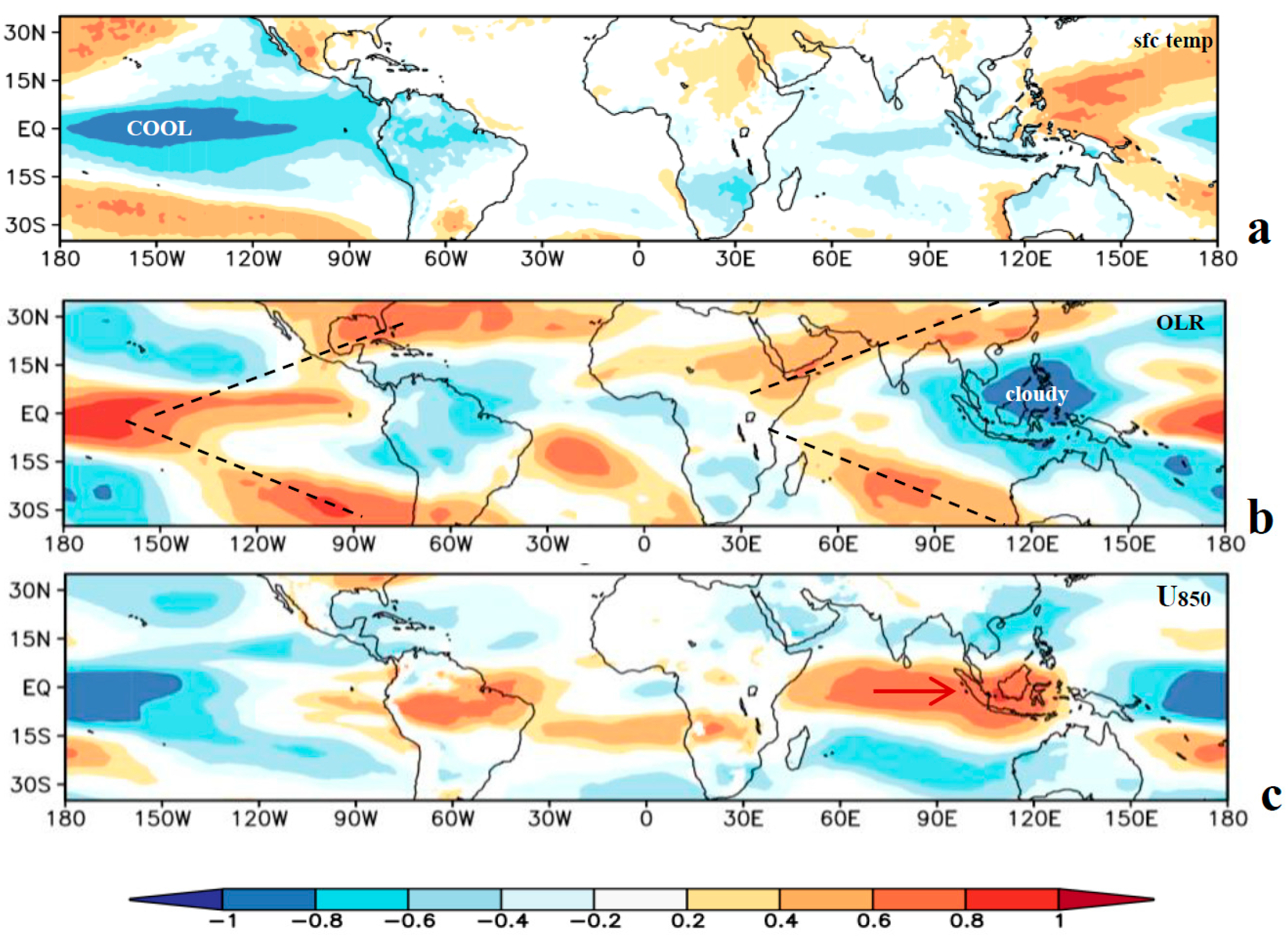

References
- Tourre, Y.M.; White, W.B. Evolution of the ENSO signal over the Indo–Pacific domain. J. Phys. Oceanogr. 1997, 27, 683–696. [Google Scholar] [CrossRef]
- Wang, B.; Wu, R.; Fu, X. Pacific–East Asian teleconnection: How does ENSO affect East Asian climate? J. Clim. 2000, 13, 1517–1536. [Google Scholar] [CrossRef]
- Trenberth, K.E.; Caron, J.M.; Stepaniak, D.P.; Worley, S. Evolution of El Niño–Southern Oscillation and global atmospheric surface temperatures. J. Geophys. Res. 2002, 107, 4065. [Google Scholar] [CrossRef]
- MacMynowski, D.G.; Tziperman, E. Factors affecting ENSO’s period. J. Atmos. Sci. 2008, 65, 1570–1586. [Google Scholar] [CrossRef]
- Yang, X.; DelSole, T. Systematic comparison of ENSO teleconnection patterns between models and observations. J. Clim. 2012, 25, 425–446. [Google Scholar] [CrossRef]
- Jin, F.-F. An equatorial ocean recharge paradigm for ENSO, part I: Conceptual model. J. Atmos. Sci. 1997, 54, 811–829. [Google Scholar] [CrossRef]
- Picault, J.; Masia, F.; duPenhoat, Y. An advective-reflective conceptual model for the oscillatory nature of the ENSO. Science 1997, 277, 663–666. [Google Scholar] [CrossRef]
- Wang, C. A unified oscillator model for the El Niño–Southern Oscillation. J. Clim. 2001, 14, 98–115. [Google Scholar] [CrossRef]
- White, W.B.; Tourre, Y.M.; Barlow, M.; Dettinger, M. A delayed action oscillator shared by biennial, inter-annual, and decadal signals in the Pacific basin. J. Geophys. Res. 2003, 108, 3070. [Google Scholar] [CrossRef]
- Jury, M.R.; Huang, B. The Rossby wave as a key mechanism of Indian Ocean climate variability. Deep Sea Res. 2004, 51, 2123–2136. [Google Scholar] [CrossRef]
- Lin, J. Ocean-atmosphere interaction in the lifecycle of ENSO: The coupled wave oscillator. Chin. Ann. Math. Ser. B 2009, 30, 715–726. [Google Scholar] [CrossRef]
- Cook, K.H. A southern hemisphere wave response to ENSO with implications for southern Africa precipitation. J. Atmos. Sci. 2001, 58, 2146–2162. [Google Scholar] [CrossRef]
- Tanaka, H.L.; Ishizaki, N.; Kitoh, A. Trend and inter-annual variability of Walker, monsoon and Hadley circulations defined by velocity potential in the upper troposphere. Tellus A 2004, 56, 250–269. [Google Scholar] [CrossRef]
- Wang, C. ENSO, Atlantic climate variability, and the Walker and Hadley circulations. In The Hadley Circulation: Present, Past and Future; Diaz, H.F., Bradley, R.S., Eds.; Springer: Dordrecht, The Netherlands, 2004; pp. 173–202. [Google Scholar]
- Xu, K.; Zhu, C.; He, J. Two types of El Niño-related Southern Oscillation and their different impacts on global land precipitation. Adv. Atmos. Sci. 2013, 30, 1743–1757. [Google Scholar] [CrossRef]
- Tartaglione, C.A.; Smith, S.R.; O’Brien, J.J. ENSO impact on hurricane landfall probabilities for the Caribbean. J. Clim. 2003, 16, 2925–2931. [Google Scholar] [CrossRef]
- Jury, M.R. Global wave-2 structure of ENSO-modulated convection. Intl. J. Climatol. 2019, 39. [Google Scholar] [CrossRef]
- Bjerknes, J. Atmospheric teleconnections from the equatorial Pacific. Mon. Wea. Rev. 1969, 97, 163–172. [Google Scholar] [CrossRef]
- Gill, A.E. Some simple solutions for heat-induced tropical circulation. Q. J. R. Meteorol. Soc. 1980, 106, 447–462. [Google Scholar]
- Lindzen, R.S.; Nigam, S. On the role of sea-surface temperature gradients in forcing low-level winds and convergence in the tropics. J. Atmos. Sci. 1987, 44, 2418–2436. [Google Scholar] [CrossRef]
- Lee, S.-K.; Wang, C.; Mapes, B.E. A simple atmospheric model of the local and teleconnection responses to tropical heating anomalies. J. Clim. 2009, 22, 272–284. [Google Scholar] [CrossRef]
- Jury, M.R.; Mulenga, H.; Rautenbach, H. Tropical Atlantic variability and Indo-Pacific ENSO: Statistical analysis and numerical simulation. Glob. Atmos. Ocean Syst. 2000, 7, 107–124. [Google Scholar]
- Fu, C.; Diaz, H.; Fletcher, J. Characteristics of the response of sea surface temperature in the central Pacific associated with warm episodes of the Southern Oscillation. Mon. Weather Rev. 1986, 114, 1716–1739. [Google Scholar] [CrossRef]
- Wang, B. Interdecadal changes in El Niño onset in the last four decades. J. Clim. 1995, 8, 267–285. [Google Scholar] [CrossRef]
- White, W.B. Tropical coupled Rossby waves in the Pacific ocean–atmosphere system. J. Phys. Oceanogr. 2000, 30, 1245–1264. [Google Scholar] [CrossRef]
- Xu, J.; Chan, J.C.L. The role of the Asian–Australian monsoon system in the onset time of El Niño events. J. Clim. 2001, 14, 418–433. [Google Scholar] [CrossRef]
- Yu, J.-Y.; Kao, H.-K. Decadal changes of ENSO persistence barrier in SST and ocean heat content indices: 1958–2001. J. Geophys. Res. 2007, 112, D13106. [Google Scholar] [CrossRef]
- Kao, H.; Yu, J. Contrasting eastern-Pacific and central-Pacific types of ENSO. J. Clim. 2009, 22, 615–632. [Google Scholar] [CrossRef]
- Geng, T.; Cai, W.; Wu, L.; Santoso, A.; Wang, G.; Jing, Z.; Gan, B.; Yang, Y.; Li, S.; Wang, S.; et al. Emergence of changing central-Pacific and eastern-Pacific El Niño-Southern Oscillation in a warming climate. Nat. Commun. 2022, 13, 6616. [Google Scholar] [CrossRef] [PubMed]
- Jury, M.R. Impact of east Pacific La Niña on Caribbean climate. Atmosphere 2025, 16, 485. [Google Scholar] [CrossRef]
- Levitus, S.; Antonov, J.I.; Boyer, T.P.; Baranova, O.K.; Garcia, H.E.; Locarnini, R.A.; Mishonov, A.V.; Reagan, J.R.; Seidov, D.; Yarosh, E.S.; et al. World Ocean heat content and thermosteric sea level change (0–2000 m) 1955–2010. Geophys. Res. Lett. 2012, 39, L10603. [Google Scholar] [CrossRef]
- Lee, H.-T. Climate Algorithm Theoretical Basis Document: Outgoing Longwave Radiation (OLR); CDRP-ATBD-0526; NOAA’s Climate Data Record (CDR) Program: Asheville, CA, USA, 2014; 46p.
- Pinzon, J.E.; Tucker, C.J. A non-stationary 1981–2012 AVHRR NDVI time series. Remote Sens. 2014, 6, 6929–6960. [Google Scholar] [CrossRef]
- Hersbach, H.; Bell, B.; Berrisford, P.; Hirahara, S.; Horányi, A.; Muñoz-Sabater, J.; Nicolas, J.; Peubey, C.; Radu, R.; Schepers, D.; et al. The ERA5 global reanalysis. Q. J. R. Meteorol. Soc. 2020, 146, 1999–2049. [Google Scholar] [CrossRef]
- Gelaro, R.; McCarty, W.; Suárez, M.J.; Todling, R.; Molod, A.; Takacs, L.; Randles, C.A.; Darmenov, A.; Bosilovich, M.G.; Reichle, R.; et al. The modern-era retrospective analysis for research and applications v2 (Merra2). J. Clim. 2017, 30, 5419–5454. [Google Scholar] [CrossRef] [PubMed]
- Folland, C.K.; Parker, D.E.; Colman, A.W.; Washington, R. Large scale modes of ocean surface temperature since the late 19th century. In Beyond El Niño: Decadal and Interdecadal Climate Variability; Navarra, A., Ed.; Springer: Berlin, Germany, 1999; Chapter 4; 374p. [Google Scholar]
- Kim, K.Y. Investigation of ENSO variability using cyclostationary EOFs of observational data. Meteorol. Atmos. Phys. 2002, 81, 149–168. [Google Scholar] [CrossRef]
- Takahashi, K.; Montecinos, A.; Goubanova, K.; Dewitte, B. ENSO regimes: Reinterpreting the canonical and Modoki El Niño. Geophys. Res. Lett. 2011, 38, L10704. [Google Scholar] [CrossRef]
- Jury, M.R. Representing the Indian Ocean Dipole. Phys. Ocean. 2022, 29, 417–432. [Google Scholar]
- Penny, S.G.; Behringer, D.W.; Carton, J.A.; Kalnay, E. The hybrid global ocean data assimilation system at NCEP. Mon. Weather Rev. 2015, 143, 4660–4677. [Google Scholar] [CrossRef]
- Andrews, M.B.; Ridley, J.K.; Wood, R.A.; Andrews, T.; Blockley, E.W.; Booth, B.; Burke, E.; Dittus, A.J.; Florek, P.; Gray, L.J.; et al. Historical simulations with Hadley3-GEM for CMIP6. J. Adv. Mod. Earth Sys. 2020, 12, e2019MS001995. [Google Scholar] [CrossRef]
- Hoell, A.; Funk, C.; Magadzire, T.; Zinke, J.; Husak, G.J. El Niño–Southern Oscillation diversity and Southern Africa teleconnections during Austral Summer. Clim. Dyn. 2015, 45, 1583–1599. [Google Scholar] [CrossRef]
- Kirtman, B.P. Oceanic Rossby wave dynamics and the ENSO period in a coupled model. J. Clim. 1997, 10, 1690–1704. [Google Scholar] [CrossRef]
- Jury, M.R.; Alfaro-Garcia, L. Peru north coast climate variability and regional ocean-atmosphere forcing. Coasts 2024, 4, 508–534. [Google Scholar] [CrossRef]
- Moeletsi, M.K.; Walker, S.; Landman, W.A. ENSO and implications on rainfall characteristics with reference to maize production in the Free State Province of South Africa. Phys. Chem. Earth 2011, 36, 715–726. [Google Scholar] [CrossRef]
- Wang, C. Atmospheric circulation cells associated with the El Niño–Southern Oscillation. J. Clim. 2002, 15, 399–419. [Google Scholar] [CrossRef]
- Yang, G.Y.; Hoskins, B. ENSO impact on Kelvin waves and associated tropical convection. J. Atmos. Sci. 2013, 70, 3513–3532. [Google Scholar] [CrossRef]
- Mpheshea, L.E.; Blamey, R.C.; Reason, C.J.C. The influence of ENSO-type on rainfall characteristics over southern Africa during the austral summer. Clim. Dyn. 2025, 63, 161. [Google Scholar] [CrossRef]
- Cai, W.; Reason, C.; Mohino, E.; Rodrigues, R.R.; Taschetto, A.S.; Garreaud, R.D.; Dewitte, B.; Poveda, G.; Ham, Y.-G.; Santoso, A.; et al. Climate impacts of the El Niño–Southern Oscillation in Africa. Nat. Rev. Earth Environ. 2025, 6, 503–520. [Google Scholar] [CrossRef]
- White, W.B.; Tourre, Y.M. Global SST/SLP waves during the 20th century. Geophys. Res. Lett. 2003, 30, 1651. [Google Scholar] [CrossRef]
- Wang, S.-Y.; Jiang, X.; Fosu, B. Global eastward propagation signals associated with the 4–5-year ENSO cycle. Clim. Dyn. 2015, 44, 2825–2837. [Google Scholar] [CrossRef]
- Ashok, K.; Guan, Z.; Yamagata, T. A look at the relationship between the ENSO and the Indian Ocean Dipole. J. Meteorol. Soc. Jpn. 2003, 81, 41–56. [Google Scholar] [CrossRef]
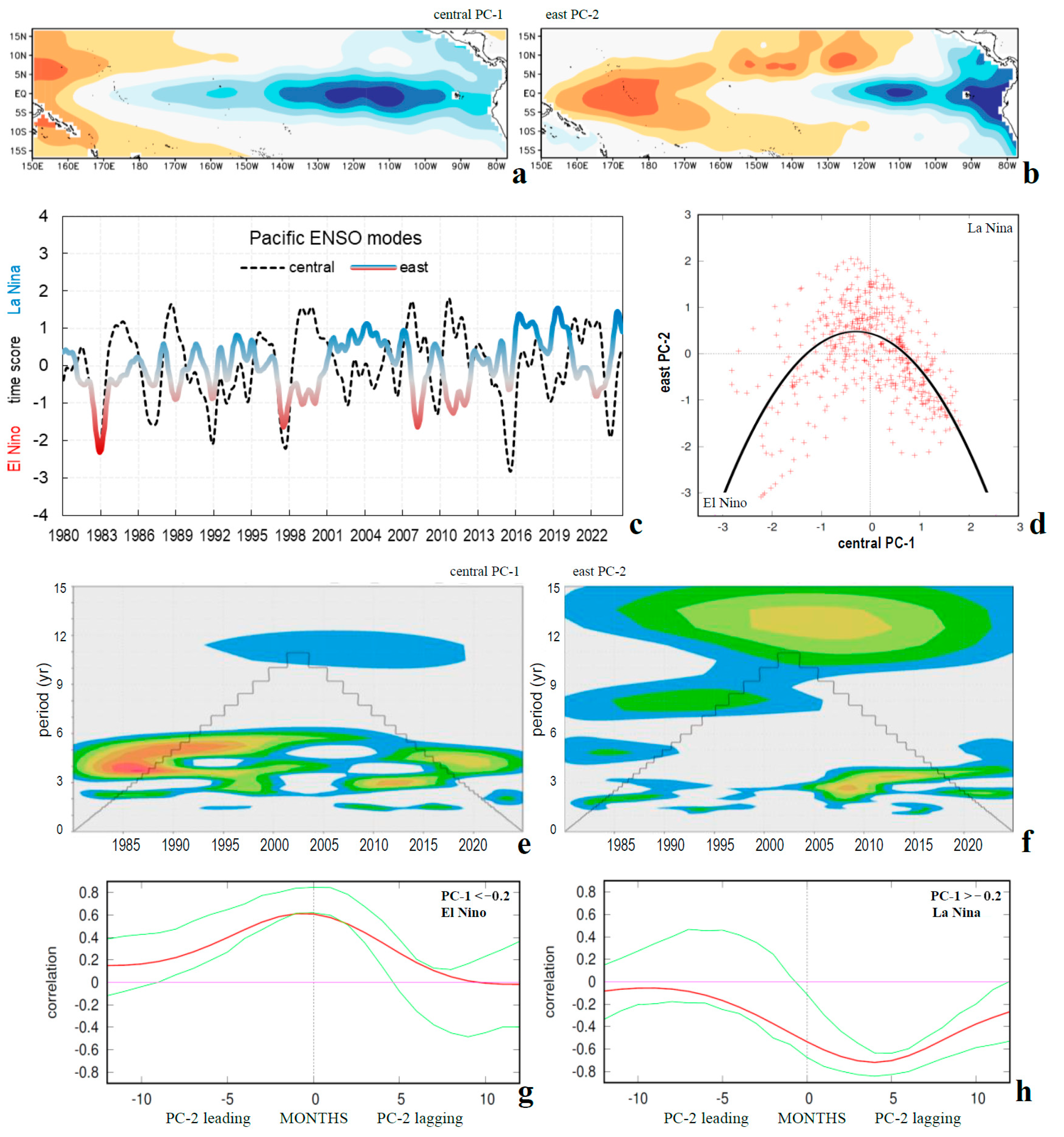
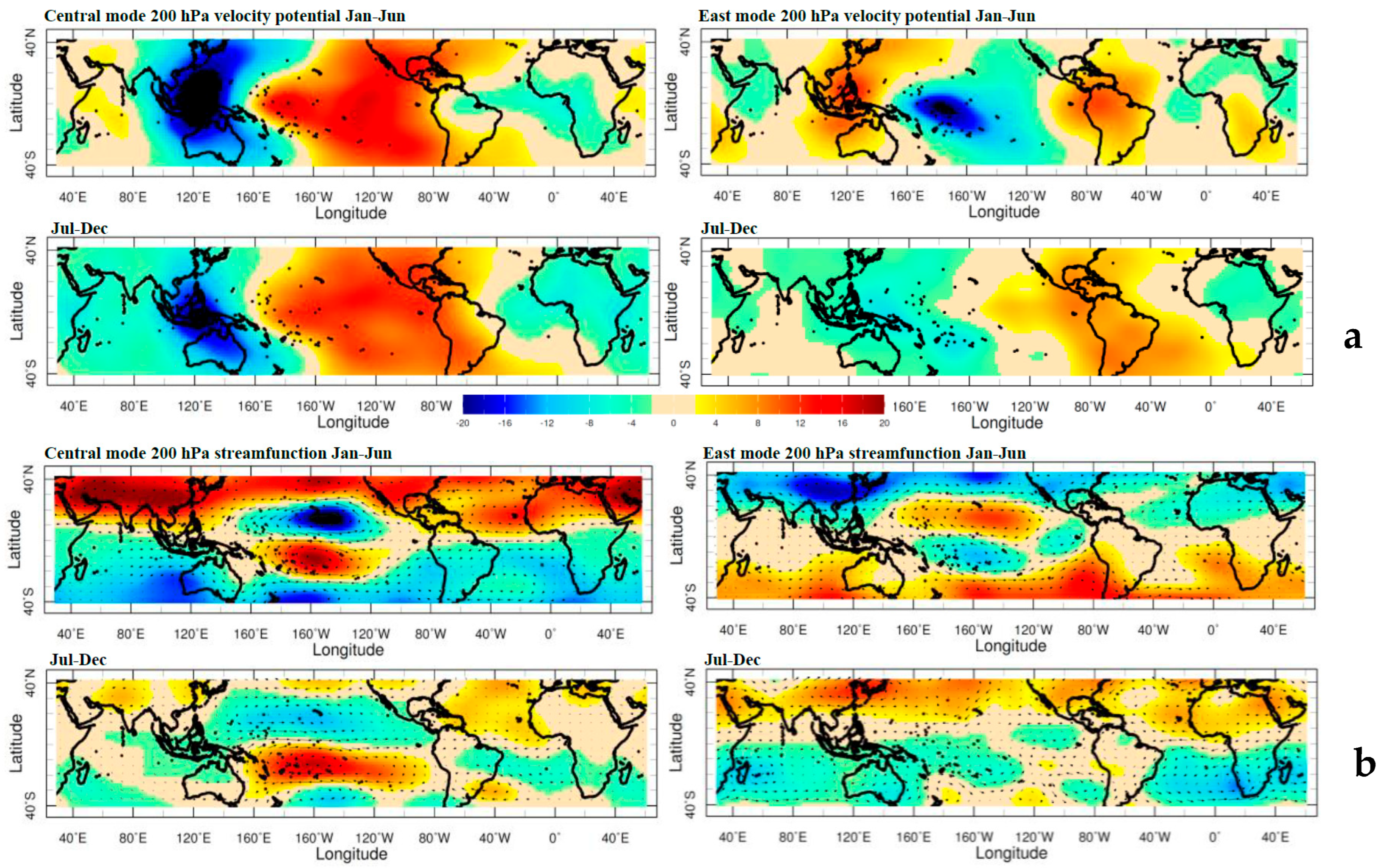
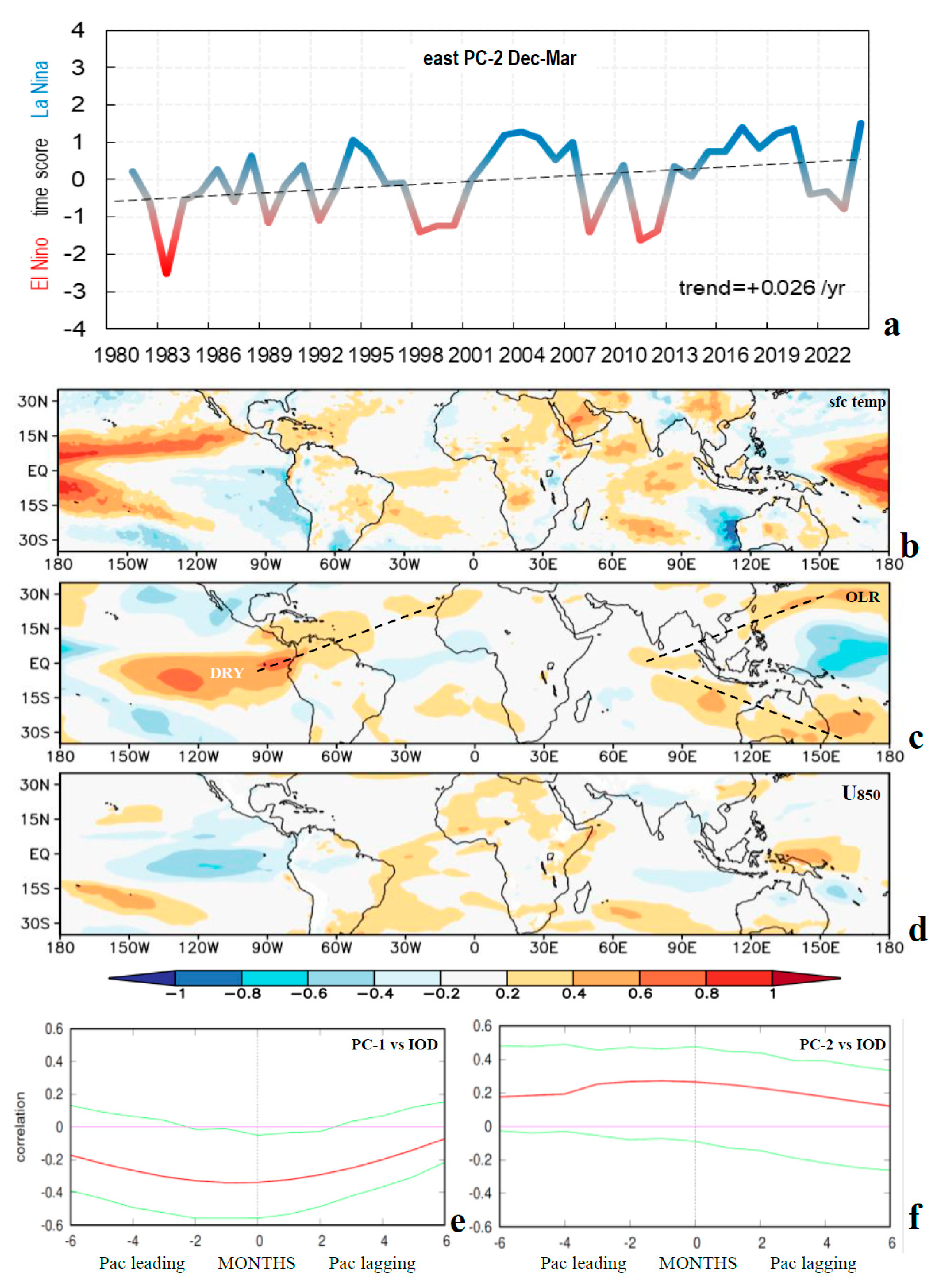
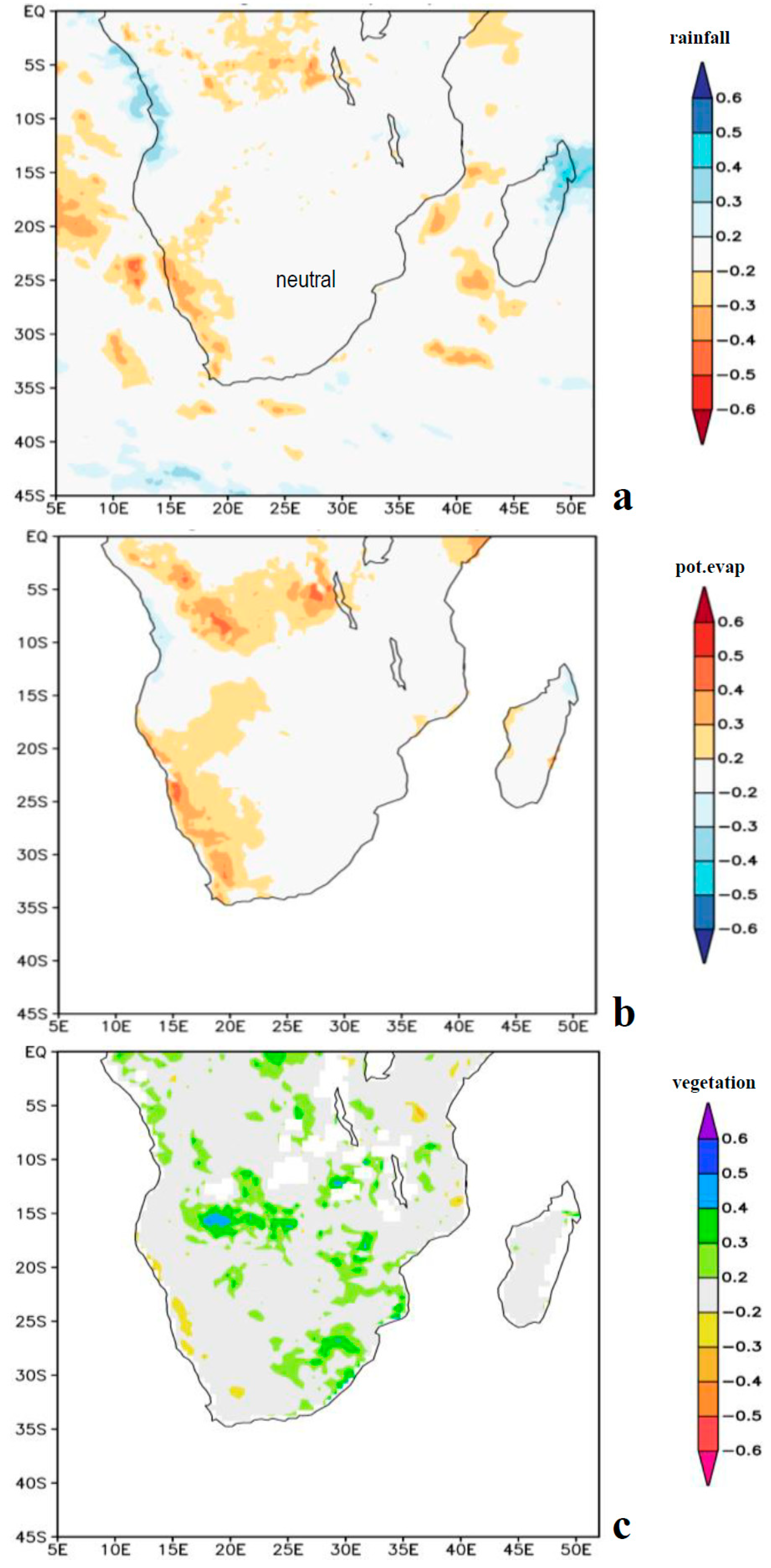
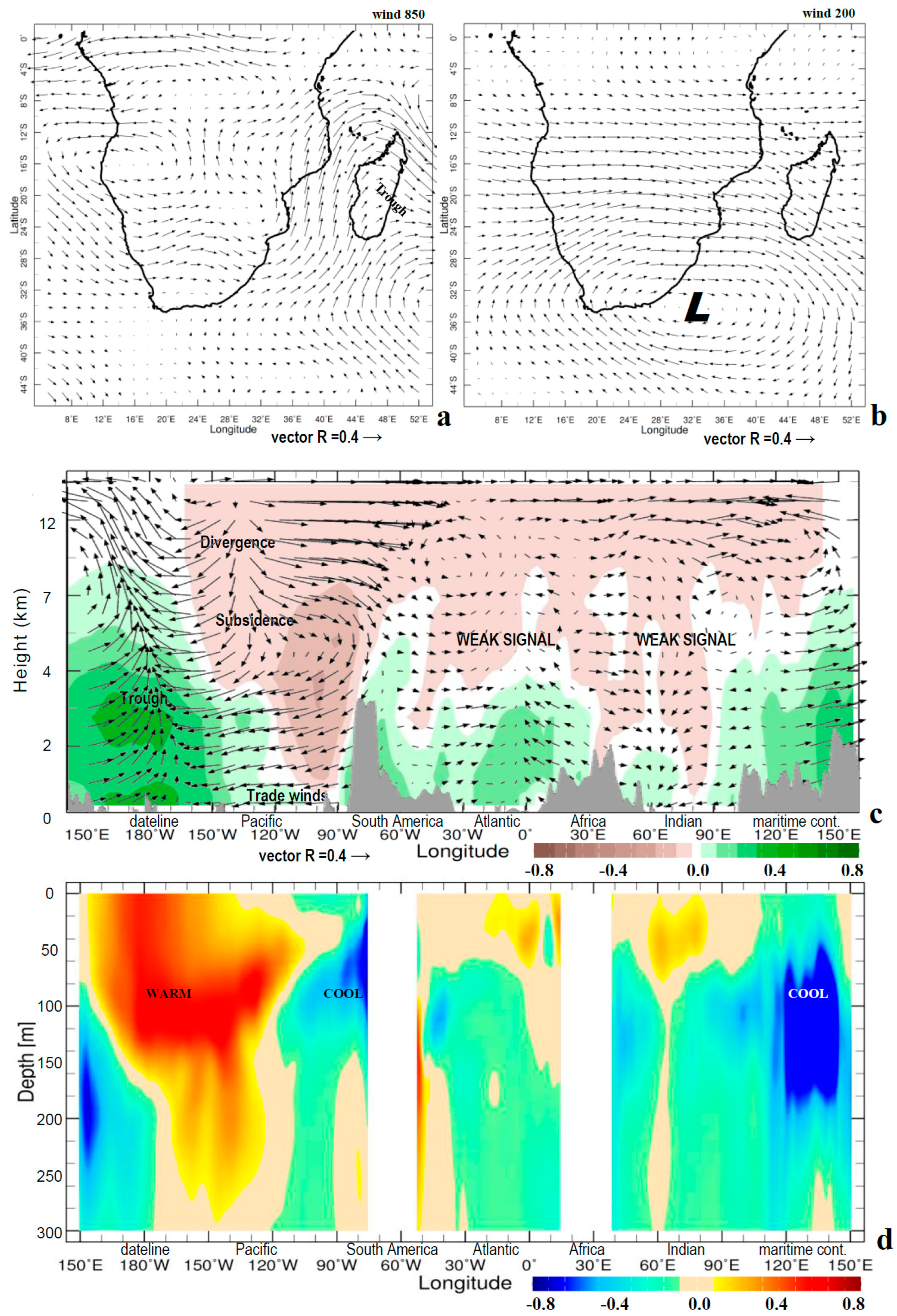

| Central | Lower | Upper | Difference | East | Lower | Upper | Difference | |
| Jul | −2.26 | 1.22 | 3.48 | Jul | −2.03 | 2.11 | 4.13 | |
| Aug | −2.35 | 1.47 | 3.82 | Aug | −1.84 | 1.89 | 3.73 | |
| Sep | −2.44 | 1.70 | 4.15 | Sep | −2.06 | 1.67 | 3.73 | |
| Oct | −2.53 | 1.94 | 4.47 | Oct | −2.39 | 1.45 | 3.84 | |
| Nov | −2.40 | 1.90 | 4.31 | Nov | −2.30 | 1.44 | 3.74 | |
| Dec | −2.26 | 1.92 | 4.18 | Dec | −2.19 | 1.41 | 3.61 | |
| Jan | −2.38 | 1.92 | 4.29 | Jan | −2.18 | 1.60 | 3.78 | |
| Feb | −2.17 | 1.59 | 3.76 | Feb | −2.25 | 1.55 | 3.79 | |
| Mar | −1.96 | 1.35 | 3.31 | Mar | −2.51 | 1.70 | 4.21 | |
| Apr | −1.86 | 1.24 | 3.10 | Apr | −2.77 | 1.91 | 4.68 | |
| May | −1.88 | 1.21 | 3.10 | May | −2.51 | 1.89 | 4.40 | |
| Jun | −1.97 | 1.21 | 3.19 | Jun | −2.24 | 1.99 | 4.23 |
Disclaimer/Publisher’s Note: The statements, opinions and data contained in all publications are solely those of the individual author(s) and contributor(s) and not of MDPI and/or the editor(s). MDPI and/or the editor(s) disclaim responsibility for any injury to people or property resulting from any ideas, methods, instructions or products referred to in the content. |
© 2025 by the author. Licensee MDPI, Basel, Switzerland. This article is an open access article distributed under the terms and conditions of the Creative Commons Attribution (CC BY) license (https://creativecommons.org/licenses/by/4.0/).
Share and Cite
Jury, M.R. Implications of East Pacific La Niña Events for Southern African Climate. Atmosphere 2025, 16, 1204. https://doi.org/10.3390/atmos16101204
Jury MR. Implications of East Pacific La Niña Events for Southern African Climate. Atmosphere. 2025; 16(10):1204. https://doi.org/10.3390/atmos16101204
Chicago/Turabian StyleJury, Mark R. 2025. "Implications of East Pacific La Niña Events for Southern African Climate" Atmosphere 16, no. 10: 1204. https://doi.org/10.3390/atmos16101204
APA StyleJury, M. R. (2025). Implications of East Pacific La Niña Events for Southern African Climate. Atmosphere, 16(10), 1204. https://doi.org/10.3390/atmos16101204






